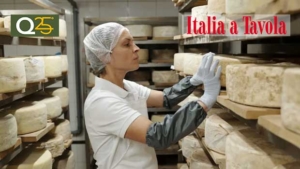
At a time when the origin of food products is increasingly central to consumer choices and business strategies, the issue of DOP and IGP certifications plays a crucial role in protecting supply chains, the local area, and the reputation of Made in Italy. Behind every quality label lies a complex process, made up of checks, rules, and shared responsibilities .
Alvise Cattelan , communications manager for CSQA Certificazioni , one of the main Italian organizations authorized by the Ministry of Agriculture to monitor and certify Geographical Indications, explains the process. He retraces the steps of a process that, in addition to ensuring authenticity and transparency, represents a true collective investment in the credibility of the agri-food system.
To obtain European recognition for a PDO or PGI product , Cattelan explains, it is first necessary to demonstrate that the designation has been used for at least thirty years and that the qualitative characteristics are directly linked to the territory of origin. This is a process of historical and scientific reconstruction: documents, photographs, recipe books, and testimonials are needed to prove the product's continued use and uniqueness.
"The first step," he explains, "is historical and documentary verification. Immediately afterward, a promotional committee is formed, made up of producers or associations, which becomes the proponent. Then the territorial perimeter is defined and the technical specifications are drawn up, the product's true identity card."
The product specification is a detailed document that establishes the name, geographical area, raw materials, production method, physical and sensory characteristics, labeling rules, and packaging. It establishes the link between quality and territory, which distinguishes a PDO from a PGI.
[…]
In recent years, sustainability has become a firmly established term in the lexicon of designations of origin. New European regulations mandate that protection consortia integrate environmental, economic, and social criteria into the management of PDO and PGI products .
Cattelan explains that sustainability in certified supply chains is based on four pillars: economic resilience, good governance, social well-being, and environmental integrity. The goal is to ensure consumers receive real added value, combining quality and responsibility.
CSQA, for its part, has developed advanced IT systems for monitoring production flows and mass balances, essential tools for ensuring integrated traceability and combating fraud or quantitative inconsistencies. "Digital control of supply chains," it notes, "is an increasingly strategic frontier for the system's credibility."
Italy is the world leader in the number of Geographical Indications , with 893 recognized products including food, wine, and spirits. The sector generates over 20 billion euros in total value and represents approximately 20% of the national agri-food turnover , with over 300 consortia and 850,000 workers. This is the picture described in the latest Ismea-Qualivita Report , which outlines a leadership born from the connection between food, territory, and community. In this context, the PDO and PGI food sector includes 328 products throughout Italy, with a value of over 9 billion euros and 4.7 billion in exports .
In this scenario, Csqa, as a third-party certification body, guarantees the conformity of 80 products which, in terms of economic value, represent over half of the national PDO or PGI production ( Qualivita Observatory on ISMEA-Qualivita 2024 data ).
[…]
Source: Italia a Tavola.net